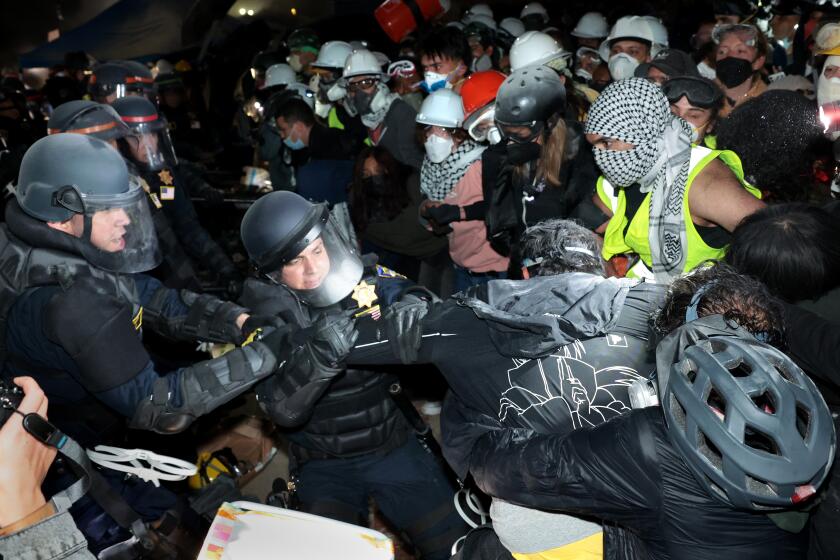They Make Legs for Others to Stand On : Education: Students in an unusual Cal State Dominguez Hills program learn to design artificial limbs and supports for the disabled.
This homework had legs, and Doug Jack tried on a pair.
The legs actually were mechanical supports fashioned by Jack’s lab partner as part of their training in a nationally recognized medical program at Cal State Dominguez Hills.
One of only four programs of its kind in the nation, it is teaching 10 students the craft of making artificial limbs and braces. The four-year program, which leads to a bachelor of science degree, gives the students a chance to marry mechanical ability and scientific aptitude to a skilled craft that offers dramatic benefits to others.
While the need for such medical specialists is growing, similar college-level programs in some places are threatened by budget cuts at the federal level. That is not the case at Cal State Dominguez Hills, where the 10-year-old program recently received its third significant federal grant since 1980.
At a recent class, Jack assumed the role of a patient whose lower legs had been damaged. He pulled on the mechanical leg supports--custom-made for him of molded plastic--and strapped them to his legs and hips. The device, called a reciprocating gait orthosis, uses thin cables and gears to facilitate movement.
The patient supplies the power by swinging one leg in front of the other and uses the braces to provide stability that weakened muscles or nerves cannot.
The program also offers clinical, hands-on experience using patient volunteers who take off their own artificial limbs so that students can practice making prostheses for them.
Jack said he had been interested in a career in auto mechanics until a friend of his father’s piqued his curiosity about being a prosthetist several years ago. The decision seemed natural, he said.
“You not only work with your hands, you’ll be able to help people out,” Jack said.
Earlier in this century, when a person lost a leg to disease or injury, it would not have been uncommon for a cabinetmaker to craft a wooden one as a replacement. The appendages were crude, often causing blood clots because they did not fit well, but they were the only alternatives to a wheelchair.
Makers of wooden limbs “were very much like artisans,” said Tom Lunsford, who co-founded the Dominguez Hills program. Today, artificial limbs are made of molded plastic. Custom-designed by trained professionals, they offer the disabled much more independence from their disabilities and wheelchairs.
“In this particular profession, you get immediate gratification,” Lunsford said. “Independence is everything to a paralyzed person. It’s really crucial. Whenever you provide that to a patient for the first time and you see a person gleaming, there’s a tremendous sense of self-satisfaction.”
The interaction is often inspirational, said Ira Schoenwald, the director of the program and its other founder.
“Our people (learn to) restore other people’s lives,” Schoenwald said. “They help little children walk and adults to lead normal lives.”
Mark Bratton, a former construction worker, said he was drawn to the field because he wanted to help people. Before enrolling, he had worked for several years as a technician helping to build prosthetic devices under the guidance of doctors and a prosthetist. He hopes to become certified in both prosthetics (artificial body parts) and orthotics (supports).
“The man on the street doesn’t realize how many amputees there are,” Bratton said. “In everyday life, you (just) see people that limp. Now that I’m familiar with gait deviation, I realize that a lot of those people are amputees.”
Outside the small laboratory where the students work is an array of artificial body parts and supports. They represent a semester’s work by the undergraduates. Although the devices have been fitted for the patients who modeled them, they are not worn outside the lab because they lack the cosmetic finish of commercial devices.
Students’ stations in the lab resemble benches in a body and fender shop, their drawers filled with hammers, clamps and sanders. The lab also has casting ovens and molding devices that are used to take plaster impressions of the patients.
The students earn degrees in health science, with a specialty in orthotics and prosthetics. The specialty, which takes up much of their junior and senior years, involves evaluating patients and designing, fabricating and fitting the devices.
The program is offered in conjunction with Rancho Los Amigos Medical Center in Downey, where some of the training takes place. After graduation, students work as interns for a year before taking a national certification exam. Entry-level salaries are between $25,000 and $30,000 a year for graduates who work in rehabilitation centers or medical equipment manufacturing firms or in small private practices.
The program, which graduates 10 students every two years, was recently awarded a three-year, $588,000 federal grant from the Rehabilitation Services Administration.
Karen Sardeson, director of education and development for the American Academy of Orthotics and Prosthetics, said the Dominguez Hills program is well thought of nationally, though the other schools that offer similar degrees all have larger programs.
They are Florida International University, the University of Texas at Dallas, and the University of Washington. New York University recently decided to terminate its baccalaureate curriculum in the specialty, and UCLA, which offers a certificate program, may also be forced to close soon, she said.
In an attempt to maintain funding to preserve the programs, Schoenwald said, the orthotics and prosthetics academy is lobbying officials in Washington.
The loss of orthotic and prosthetic programs comes despite the rising demand for such services, he said. The number of people needing prostheses increased from 271,000 in 1977, to 421,600 in 1988, a 55.6% increase. The number of those using the services of an orthotist rose 28.8% over the same period, from 3.5 million to 4.6 million.
Schoenwald said the increased need for prosthetic and orthotic devices is due to a general rise in population coupled with more accidents.
The Dominguez Hills students will graduate in late December. Bratton said he is looking forward to working closely with patients and seeing the difference his new skills will make.
Recalling his earlier work as a prosthetist’s assistant, he talked about a 5-year-old boy who had his leg amputated below the knee. For the next five years, the boy came back for refittings.
“It was just rewarding to see him use the prosthesis and be able to play ball,” Bratton said.
More to Read
Sign up for Essential California
The most important California stories and recommendations in your inbox every morning.
You may occasionally receive promotional content from the Los Angeles Times.






